Method of rapid production of hybridomas expressing monoclonal antibodies on the cell surface
a monoclonal antibody, cell surface technology, applied in the introduction of vector-based foreign material, genetically modified cells, new breed animal cells, etc., can solve the problems of cell death in microtiter wells, time-consuming and laborious steps in generating monoclonal antibodies, and inconvenient hybridoma technology
- Summary
- Abstract
- Description
- Claims
- Application Information
AI Technical Summary
Problems solved by technology
Method used
Image
Examples
examples
[0239]This invention shows that the lack of antibody receptors Igα and / or Igβ, is the major limitation to surface presentation of antibody in hybridomas. The membrane form of antibody binds these two receptors through the membrane spanning domain that is on the C-terminus of the full-length heavy chain (mHC) as shown in FIG. 1. Most myelomas have lost the ability to produce Igα and / or Igβ, and the resulting hybridoma fusions no longer present surface mAb because they lack the the Igβ receptor or the Igα and Igβ receptors (Kanavaros et al., 1995). Myelomas impart this lack of surface presentation of antibody to most hybridoma cell lines, even though many hybridomas are derived from early or mid-stage B-cells, which themselves present surface mAbs (Milcarek et al., 1996).
[0240]Engineering the constitutive expression of Igα and / or Igβ: The cDNAs encoding the two receptor sequences Igα and Igβ were PCR amplified from a mouse spleen cDNA library (Clontech). Restriction endonuclease cloni...
PUM
| Property | Measurement | Unit |
|---|---|---|
| Fraction | aaaaa | aaaaa |
| Fraction | aaaaa | aaaaa |
| Fraction | aaaaa | aaaaa |
Abstract
Description
Claims
Application Information
 Login to View More
Login to View More - R&D
- Intellectual Property
- Life Sciences
- Materials
- Tech Scout
- Unparalleled Data Quality
- Higher Quality Content
- 60% Fewer Hallucinations
Browse by: Latest US Patents, China's latest patents, Technical Efficacy Thesaurus, Application Domain, Technology Topic, Popular Technical Reports.
© 2025 PatSnap. All rights reserved.Legal|Privacy policy|Modern Slavery Act Transparency Statement|Sitemap|About US| Contact US: help@patsnap.com



